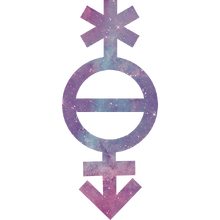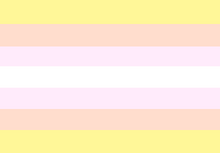m (Reverted edits by IWander (talk | block) to last version by Lavender Jade) Tag: rollback |
(Please, stop adding content that is not correct. If you are not pangender, then don't try to define pangender.) Tag: rte-wysiwyg |
||
| Line 10: | Line 10: | ||
Pangender = binary genders (100% female and 100% male) + known genders + unknown genders. |
Pangender = binary genders (100% female and 100% male) + known genders + unknown genders. |
||
| + | <p class="MsoNormal" style="margin-bottom:10.0pt;line-height:115%;mso-pagination: none;mso-layout-grid-align:none;text-autospace:none">The greek prefix “pan” refers to “everything” or “all”, therefore, pangender could mean “all genders”, however the genders of pangender people are limited to their own life experience. Pangenders only identify with genders of their own culture. Pangenders do not try to identify with ethnic genders outside their own culture (and all of them by the way), because that’s impossible (one would have to spend their life in all cultures). Attempting to identify with ethnic genders outside one’s culture is colonialist/appropriative; people who do that and call themselves pangender should not be considered as an example of pangender. This applies to all other non-binary identities: one cannot identify with gender(s) outside their own culture.</p> |
||
| − | Some pangender people literally identify as all genders, even ones that are considered [[Exclusive_Genders|exclusive]], while others only identify as all the non exclusive genders as well as the exclusives that they meet the requirements for. |
||
[[File:Pangender-flag-2-a.png|thumb|220x220px]] |
[[File:Pangender-flag-2-a.png|thumb|220x220px]] |
||
Revision as of 17:41, 23 February 2016

Pangender (and/or Omnigender) is a non-binary gender experience which refers to a wide multiplicity of genders that can (or not) stretch to the infinite (meaning that this experience can go beyond the current knowledge of genders). This experience can be either simultaneously or over time.
Being pangender does not require that one knows everything about all the established genders nowadays; being pangender goes beyond the known genders.
Pangender can express gender fluidity or not; for example, a pangender person can manifest a genderflux, flowing from pangender to agender.
Panflux is a gender identity consisting of pangender + genderflux.
Pangender = binary genders (100% female and 100% male) + known genders + unknown genders.
The greek prefix “pan” refers to “everything” or “all”, therefore, pangender could mean “all genders”, however the genders of pangender people are limited to their own life experience. Pangenders only identify with genders of their own culture. Pangenders do not try to identify with ethnic genders outside their own culture (and all of them by the way), because that’s impossible (one would have to spend their life in all cultures). Attempting to identify with ethnic genders outside one’s culture is colonialist/appropriative; people who do that and call themselves pangender should not be considered as an example of pangender. This applies to all other non-binary identities: one cannot identify with gender(s) outside their own culture.


Pangender pride flags
The proposed pangender pride flags are based on the agender pride flag. The colors are very bright so that they represent the multiplicity of genders (because the white light, in the electromagnetic spectrum, is a combination of all colors). The yellow color represents all the genders that are not related to female and male; the light red color represents the transition to the genders which are related to female and male; the light violet-pink color represents the combination of female and male; the white color represents the blend of all these genders. These flags were proposed by Pangendering.